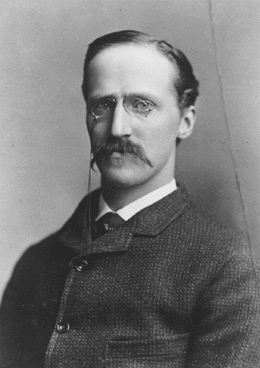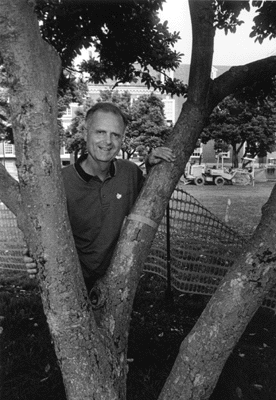
Initiative tops goal at $1.52
billion
The Johns Hopkins Initiative ended June 30, after attracting
$1.52 billion in commitments that nearly doubled the university's
number of named scholarships and fellowships, endowed 130
professorships and two deanships and modernized Hopkins
facilities for patient care, research, teaching and student
life.
The campaign's original goal was $900 million
for the university and Johns Hopkins Health System. That was
increased to $1.2 billion in 1998. Johns Hopkins becomes the
sixth institution to raise $1.5 billion or more in a single
campaign.
Full story...
 A faculty for physics
A faculty for physics
When Daniel Gilman was appointed president of The Johns Hopkins
University in 1875, the trustees, none of whom were educators,
left the matter of recruiting a faculty in his hands. With an eye
to the future, Gilman sought to fill the ranks with "young
scholars of promise," likely to become important figures in their
fields. Gilman solicited recommendations for students or former
students, or younger colleagues respected by their peers. In the
discipline of physics, one name often repeated was Henry Augustus
Rowland.
Born in Pennsylvania in 1848 and trained as a
civil engineer, Rowland was in his late 20s and isolated at
Rensselaer Polytechnic Institute when he came to Gilman's
attention. Gilman realized that Rowland, who had abandoned
engineering for physics and electricity, was "a young man of rare
intellectual powers and of uncommon aptitude for experimental
science." Gilman offered Rowland the position of professor of
physics, at a beginning salary of $1,600. The name "Johns
Hopkins" at that time meant only a businessman who had left a
fortune to found a university, so it was a gamble for Rowland as
well as for Gilman. Upon accepting Gilman's offer, he wrote, "I
have gone there on faith, and will do my best to make the
institution a success." Rowland became the very first faculty
member hired for the new university.
Full story...
 Arborist roots, roots, roots for the Homewood
trees
Arborist roots, roots, roots for the Homewood
trees
When it comes to protecting or saving trees at construction
sites, most developers and construction companies view arborists
as tree-hugging obstructionists, says Chris Cowles, an arborist
and urban forester currently working on the Great Excavations
project on the Homewood campus.
"Some people think I work for the government,"
Cowles says. "They say, 'Oh, you're here to inspect the
trees.'"
Even people who want to do the right thing
often fail to consider what effect construction will have on the
trees, Cowles says. And construction damage to trees can appear
three or four years down the line.
Full story...
| [ The Gazette | Search | About the Gazette | Send us Email ] |
The Gazette
 The Johns Hopkins University
The Johns Hopkins University
 Suite 100
Suite 100

3003 North Charles Street
 Baltimore, Maryland 21218
Baltimore, Maryland 21218
 (410) 516-8514
(410) 516-8514  gazette@resource.ca.jhu.edu.
gazette@resource.ca.jhu.edu.
